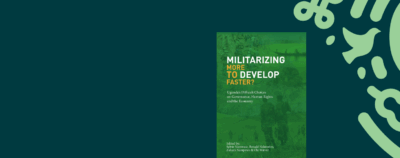Concepts like “spirit” or “matter” or “body” escape sharp definitions. They are productive precisely because of their indeterminacy. This makes it possible to put them to use in widely different contexts. They are suggestive rather than precise. What, for instance, has the Holy Ghost, part of Christianity’s trinity, to do with Hegel’s transcendental Geist of history, or with the various spirits that possess people the world over? At first blush, perhaps nothing. But, on the other hand, Pentecostals do speak in tongues, as if they are possessed, and there seems to be an almost Hegelian notion in Christianity that history is moved by a transcendental purpose. The rich traditions of spirits and spirit possession in Islam that find their fullest expression in Sufi cults have been under attack from some scripturalist movements that find them to be antithetical to the theological core of Islam. Nevertheless, one finds everywhere in the Muslim world a vibrant connection between religious healing and control over the spirit world. When we use the English word “spirit” we connect different semantic universes within the Western tradition, but also connect with other traditions and their debates outside of the West.
Spirituality, a term that is derived from spirit, is one of the most important terms for understanding modernity. It acquires a new significance in the age of scientific experimentation, and in the context of newly emerging nationalism and imperialism. The second half of the nineteenth century saw a huge rise in the interest in spirits and spirituality. In the 1850s in France Allan Kardec communicated with spirits through a planchette, a little plank with a pencil attached to it that allowed automatic writing guided by spirits. He wrote a series of books, collectively named the Spiritist Codification. Leading French intellectuals, like Victor Hugo, became enthusiastic followers of Spiritism. In 1878, Madame Helena Blavatsky and Colonel Henry Olcott founded the Theosophical Society in New York. Olcott had been a colonel in the Union Army in the Civil War. Like so many others who had been in that war, he had become interested in communicating with the spirits of the dead. On a trip to Vermont in 1874 to visit the Eddy family, known to be successful in their communications with spirits, he had met Madame Blavatsky, a Russian who claimed to have visited Tibet. She could communicate not only with spirits, but also with the Masters who ruled the universe and were located in the East. Blavatsky made the brilliant move to connect the communication with spirits with spirituality, the unbounded tradition of mysticism.
Modern abstract art is a hallmark of modernity and the great pioneers of abstract art in the early twentieth century, Wassily Kandinsky and Piet Mondrian, understood the move from representation to abstraction as “spiritual.” Kandinsky refers in his Über das Geistige in der Kunst (The Spiritual in Art), one of the most influential texts by an artist in the twentieth century, to Blavatsky as a great inspiration. Similarly, Mondrian, in his use of geometric form, was directly inspired by reading Blavatsky’s Isis Unveiled. In 1909 Mondrian became a member of the Theosophical Society. For both Kandinsky and Mondrian spirituality provided an avenue to explore reality beyond the conventional methods of science and materialism.
Spirituality was (and still often is) thought to be more abundant in “the East” than in “the West,” which was thought to be materialistic and over-rational. The East was a site of spiritual imagination, made accessible for a Western audience by colonial conquest and orientalist translation. Asians were not passive recipients of this process of orientalization, but active promotors of it. The Indian Swami Vivekananda, who became famous thanks to his performance at the World Parliament of Religion in Chicago in 1893, was immensely successful in his propagation of Yoga as the scientific base of Hindu spirituality. His fellow Bengali, Rabindranath Tagore, the first Asian Nobel Laureate of Literature, tried to go beyond national boundaries by promoting a Pan-Asian Spirituality. This endeavor stalled when Japanese intellectuals rejected Tagore’s pacifism as the sign of a colonized people and emphasized a Japanese spirituality with militaristic overtones.
Spirituality could be understood as a universalistic, unifying alternative for the religious, racial, and ethnic divisions between peoples, but it could also be made into a characteristic of a nation: the spirit of the nation. This tension is, in fact, never resolved. Spiritual leaders like Mahatma Gandhi or the Dalai Lama have been simultaneously spreading a universal message and fighting for national independence. Nationalism often combines a variety of religious and cultural traditions into a unifying spirituality that characterizes a particular people. Rather than the bounded traditions of religion, especially when institutionalized in churches, spirituality could be used to transcend divisions.
The modern Western “invention” of spirituality had to come to terms with the rich repertoire of traditions of spirits and spirit possession in the East. Madame Blavatsky and Colonel Olcott tried to align themselves to Hinduism, but the spirits of the dead are to be pacified and avoided in Hindu India, not to be communicated with. This is very different in China. The earliest forms of writing in China were spirit writing. This kind of writing was not meant to put human speech into writing, but to communicate with the spirits. They were talismanic signs that enabled the writer to communicate with the hidden powers of the universe or even control them. Spirit writing cults were a crucial part of religion in Southern China until they were repressed by the Communist state in the 1950s.
Perhaps Edward Tylor’s Victorian definition of religion as the belief in spiritual beings is typical for the ubiquity of spirits in the world of our imagination. Spirit can be used as a contrastive term as the opposite of “matter” and of “body.” But the spirit is materialized in writing and embodied in spirit possession, connecting the immanent world with the transcendent in myriad ways.













